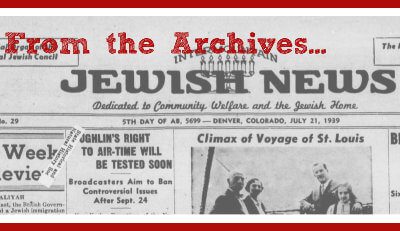Have you heard of the Colorado Jewish Indian who fought in an 1868 battle near Wray? Neither had we! OK, he wasn’t actually an Indian, the headline in the July 26, 1951 edition of the IJN led us slightly astray. Here’s how it breaks down: Sigmund “Sid” Shlesinger was a 19-year-old from Cleveland who was a scout in Colorado. He boasted of gruesome exploits against local Indians and also claimed to kill and eat a coyote due to “the lack of grub.”

Sid Shlesinger, the ‘Colorado Jewish Indian Fighter’
He recorded his exploits in a diary, which in 1951 had come into the possession of the American Jewish Archives in Cincinnati, hence the IJN article.
The Battle of Beecher Island, in which Shlesinger participated, saw “a band of fifty mounted scouts” hold off “about a thousand Cheyenne and Sioux warriors for nine days during September, 1868, in Eastern Colorado.”
According to the IJN article, Shlesinger was “immortalized by historians,” who referred to him as “the little Jew,” a moniker given to him by General James Fry who in his book Army Sacrifices wrote of Shlesinger: “When the foe charged on the breastworks/ With the madness of despair/ And the bravest souls were tested/ The Little Jew was there.”
Fry’s poem speaks to longstanding stereotypes about colonizers — “bravest of souls” — versus Indians — “madness.” The article in the IJN also adopts this perspective.
The Battle of Beecher Island, also known as the Battle of Arikaree Fork, saw the deaths of Chief Roman Nose of the Northern Cheyenne and Lt. Frederick Beecher, and was a key battle in a years-long conflict between Plains Indians and US forces for control of the Great Plains. Shlesinger’s diary became one of those known sources of the battle that saw five scouts and dozens of Plains Indians die.
Following the battle, Shlesinger returned to his family in New York and later moved to Cleveland (some sources, including the IJN, imply he was from Cleveland at the time of the battle; we were unable to verify) where he went into the tobacco business and became a well-respected member of Cleveland’s Jewish community.
Though wars in the West against Native Americans are rightly viewed very differently today, there is a David-and-Goliath aspect to the Battle of Beecher Island. From a broad lens perspective, Native Americans ultimately had little to no power against encroachments by colonizers into their territory, but in that battle it was 50 US Americans against a revered 1,000-strong band of fighters under Chief Roman Nose (also known as Chief Hook Nose). Shelsinger played a pivotal role and for that he was still remembered years later by his commanding officer, Gen. Forsyth who wrote of him:
“He had never been in action prior to our fight with the Indians and throughout the whole engagement which was one of the hardest, if not the very hardest, ever fought on the Western plains, he behaved with great courage, cool persistence and a dogged determination that won my unstinted admiration as well as that of his comrades, many of whom had seen service throughout the War of Rebellion on one side or the other.”
Read more about Sigmund Shlesinger on JewishMilitary.org. His full diary can be found in the July, 1952 edition of The Colorado Magazine.
This online feature explores the IJN’s new digital archive, discovering the news of the week, years ago.
















